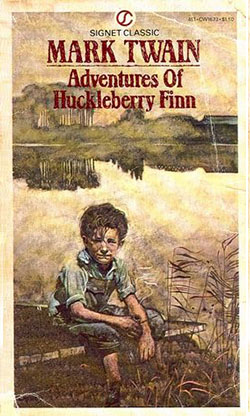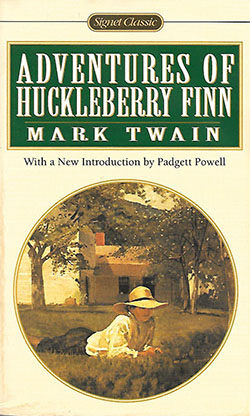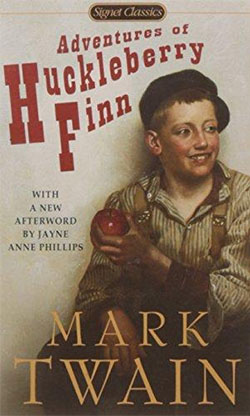
CD5, 50¢, August 1959. Cover artist unknown. 288 pp.
He has no mother, his father is a brutal drunkard, and he sleeps in a hogshead. He’s Huck Finn, a homeless waif, a liar and thief on occasion and a casual rebel against respectability. But on the day that he encounters another fugitive from trouble, a runaway slave named Jim, he also finds for the first time in his life love, acceptance and a sense of responsibility. And it is in the exciting and moving story of these two outcasts fleeing down the Mississippi on a raft, that a wonderful metamorphosis occurs. The boy nobody wants becomes a human being with a sense of his own destiny and the courage to choose between violating the code of the conventional and betraying the person who needs him most. Rich in color, humor and the adventurous frontier experience of the Mississippi, this great novel vividly recreates the world, the people and the language that Mark Twain knew and loved from his own years on the riverboats. “All modern American literature comes from one book by Mark Twain called Huckleberry Finn.” — Ernest Hemingway
With an Afterword by George P. Elliott
Let me be clear at the outset: as someone who was assigned this book in high school and failed to read most of it, and has since felt a pang of shame whenever this book is mentioned — and, as books go, it’s mentioned pretty often — I am now pleased and relieved to be able to say truthfully: I, a literate American, have of course read and attended to every word in Huckleberry Finn. I live in virtue.
Okay. Sacrilege follows.
The standard take is that Tom Sawyer is a children’s book, but Huckleberry Finn is a masterful novel, a work on a whole other plane.
My counter-take: Huckleberry Finn is the sequel to Tom Sawyer.
In fact, it’s the second book in the Tom Sawyer YA series. In its final pages it sells its sequel, Hardy Boys-style, explicitly indicating that it will soon be followed by Huck Finn and Tom Sawyer Among the Indians. (… though after writing a few chapters of that work Twain abandoned it. Later he published Tom Sawyer Abroad and Tom Sawyer, Detective, and then worked for a while on Tom Sawyer’s Conspiracy but left it incomplete.) The final sentence, in which Huck says he soon intends to “light out for the Territory,” has become an idiom, lovingly invoked for its supposed resonance and depth (“ah, in a sense, don’t we all inwardly light out toward our own private frontiers,” that sort of thing) — when in fact it’s the equivalent of “but we’d soon find ourselves caught up in The Shore Road Mystery.” To me this is emblematic of the tradition of stubborn overreading that burdens this book.
Huckleberry Finn is indeed somewhat more philosophically expansive than Tom Sawyer, but that’s because it was written with even less of a plan and even less of a specific flavor or character. It’s not more ambitious, it’s just less narrow because it doesn’t have the focus that comes with being purposeful. It’s riff after riff, a totally inconsistent sequence of disorderly invention, some of which is trenchant and striking and memorable, and some of which is utterly tedious. It’s frankly a big mess. It’s untamed, and I would never deny that that can be a thrill — sometimes it feels like you’re getting a glimpse of stuff that doesn’t “belong” in a book, stuff that’s been smuggled in — but recklessness is different from bold vision. My impression with Tom Sawyer was that Twain was wandering aimlessly through his own dreamscape, on instinct, and that impression is only deepened here. It’s a thing, it’s an interesting thing, but it’s not what “great novel” means to me.
So: Jim. This is a great American character? For this Mark Twain is hailed as a profound humanist? I’m no minstrel show expert but surely the noble clown, the pitiable clown, the pathos of the clown, was a part of that tradition as it is of every clown tradition. Right? And this is surely a minstrel show. It boggles my mind that when Twain has Huck struggle briefly and ostentatiously with the fact that Jim’s a person after all, or has Jim, in the middle of his one-dimensional clowning, say a few “noble” things, the cultural establishment is eager to call out a unique literary moment of transcendent human insight. Yuck! Self-important minstrelsy is still minstrelsy. The question of slavery and indeed of racism itself ought not be one of whether we’re willing to shed tears for a poor, simple, noble-hearted slave — or more to the point, whether we’re willing to shed tears for a white boy coming to the realization that a black man is a human being. Tears too can be smug.
I’m not saying it isn’t done with panache. “All right I’ll go to hell” is indeed a striking moment — clearly calculated to have a big booming self-righteous impact — but let’s not miss the forest for the one tree, decorated with Christmas ornaments though it may be.
The infamous word that is on every page of this book is not there by coincidence, nor is it part of a unique authorial scheme of edgy boldness. It simply is because it was. This book is the kind of irredeemably 19th-century product that in EVERY OTHER INSTANCE has been relegated to controlled laboratory study and banished from the actual cultural sphere. Yet this one somehow got through. I’m hardly here to argue that it should have been more censored — if anything, I think we should be less censorious of old stuff in general, across the board — I’m just saying I question the rationale by which this exception has been made.
I’m inclined to attribute it in no small part to Ernest Hemingway’s “All modern American literature comes from one book by Mark Twain called Huckleberry Finn,” a load-bearing quotation if ever there was one. Does anyone really believe this is remotely true? It’s just an example of what we now call a “hot take.” Hot takes don’t have shelf lives; they’re supposed to die immediately after being uttered. And since when does anyone care what Ernest Hemingway said about anything? I defy the Huckleberry Finn establishment to break up with this quote. It’s a codependent relationship; it’s unhealthy. The time has come. Go ahead, sell a copy of the book without the quote on the back. I dare you. You’ll be better for it. You’ll see yourself more clearly.
Okay, next gripe: The dialect narration is an obnoxious and disingenuous ploy. It’s more minstrelsy, Huck being a kind of minstrel too. The whole enterprise is fundamentally exploitative condescension: “Listen to the way simple folk talk! Listen to the way simple folk think! Warms your heart and stirs your spirit, don’t it?” Plus I have no patience left for the “holy fool” conceit by which authors get to moralize by aw shucksing it all into the irrefutable mouths of babes. “If you don’t like my cranky opinions, just take it from this folksy puppet! Life is like a box of chocolates!”
Verisimilitude is a transparently weak excuse for writing an entire novel in ostentatious and labored dialect; he’s clearly unconcerned with verisimilitude in a thousand other ways. Only along certain axes. This dimension, this “ah lack the way you talk!“-speak is a fixture that appealed to him in the Sears catalog and he bought it. He saved his money elsewhere but this he went ahead and bought. I reckon it ain’t ’cause he was a stickler for accuracy, no sir. Why, I seen plenty o’ them book authors who’d sooner eat a live skunk than waste their time writin’ a heap of dialect. But this here Mister Mark Twain, well, somehow it sat right with him. If you ask me it ain’t but the sign of a bad upbringing, to go around imitatin’ and imposteratin’ every little syllabus a body’s likely to pronunciate, but all the time be fillin’ them characters’ mouths with a bunch of unnatural mistakes and malaporpoises that I reckon are sposed to be sweet and funny and make all the ladies coo and simper like, when any fool knows them characters would’ve never said nuthin’ of the kind! It’s a damned shame when a growed man like that don’t have the common decency to write his own words in his own pen, and admit what’s his and what’s real, and what he just made up to satisfy his own confounded fancy.
Furthermore the map, he’s all over it. He’ll do whatever gets him through each paragraph with a sense of pride. We’re told that Tom Sawyer “lifts his hat ever so gracious and dainty, like it was the lid of a box that had butterflies asleep in it and he didn’t want to disturb them.” Lovely, but, come on, is that really Huck talking? There is no Huck.
Over the course of several weeks of increasingly slow reading, I grew to feel that I was humoring an extremely self-involved acquaintance who wanted constantly to be showing off, doing voices, making fun of things he thought were dumb, making pronouncements, and generally holding court, and that I was going along mostly because I was afraid he’d unleash tetchy fire on me if I didn’t.
I’m glad to be done and out of his company. And I came away with more sympathy for my high school self than I expected.
Once again, illustrations are woven into the fabric of the original edition, Twain personally approved them (some of them enthusiastically), and their omission from future editions continues to seem to me extremely unfortunate. I read from a scan and am glad I did. (I suppose some might argue that I probably would have thought more highly of the book if I had read a “standard” non-illustrated edition. But that’s exactly because the “standard” reading is a wishful, revisionist one.)
All this said, I can’t deny that Twain can turn a sentence now and again. Here’s our rather famous excerpt, the showpiece passage from part of the book that everyone actually likes:
Next we slid into the river and had a swim, so as to freshen up and cool off; then we set down on the sandy bottom where the water was about knee deep, and watched the daylight come. Not a sound anywheres — perfectly still — just like the whole world was asleep, only sometimes the bullfrogs a-cluttering, maybe. The first thing to see, looking away over the water, was a kind of dull line — that was the woods on t’other side; you couldn’t make nothing else out; then a pale place in the sky; then more paleness spreading around; then the river softened up away off, and warn’t black any more, but gray; you could see little dark spots drifting along ever so far away — trading scows, and such things; and long black streaks — rafts; sometimes you could hear a sweep screaking; or jumbled up voices, it was so still, and sounds come so far; and by and by you could see a streak on the water which you know by the look of the streak that there’s a snag there in a swift current which breaks on it and makes that streak look that way; and you see the mist curl up off of the water, and the east reddens up, and the river, and you make out a log-cabin in the edge of the woods, away on the bank on t’other side of the river, being a woodyard, likely, and piled by them cheats so you can throw a dog through it anywheres; then the nice breeze springs up, and comes fanning you from over there, so cool and fresh and sweet to smell on account of the woods and the flowers; but sometimes not that way, because they’ve left dead fish laying around, gars and such, and they do get pretty rank; and next you’ve got the full day, and everything smiling in the sun, and the song-birds just going it!
The tonal deadpan at “but sometimes not that way, because they’ve left dead fish laying around” is humor somewhere midway in the process of transmutation into serious aesthetics. For me, a gesture like that is as stimulating as literature gets — bracing! — and when Twain’s at his very best, he’s there. Only some of this book is his very best, but indeed some of it is. I’ll try to be grateful for that.
CP597, 60¢, 1972.
One more with the original design. Remember how at one point in the 80s they tried to get away with dropping the The from The Adventures of Tom Sawyer? It’s because of the mismatch in the two titles. Cover designers hate inconsistency. Here in their first round of covers they tried to resolve the problem the other way, by sticking a The on to Huck. Forgivable but wrong.

CT694, 75¢, 1974.
CQ953, 95¢, 1977.
CY1075, $1.25, 1979.
CW1317, $1.50, 1980.
CE1434, $1.75, 1981.
70s branding.

CW1673, $1.50, 1982. (price drop!)
The brief “centered logo” period ushers in this attractively dauby new painting. Huck seems a little young maybe, but what can I say, I like the textures. This seems to precede the Tom Sawyer illustration from the same artist, whose identity remains unclear. With no further information available, my wild guess of “Robert Lapsley” still stands.
[2022 edit: Confirmed! The “Lapsley” signature is in fact visible in the extreme lower left corner of CW1673; the copy above just happens to be creased there. It’s cropped out of all subsequent reprints.]
(“The” disappears from both titles at once. Good try but now you’ve gone too far.)


CE1912, $1.75, 1983?
CJ2373, $1.95, 1987?
CE2373, $2.95, date unknown.
Second rebranding. The “100th anniversary” burst seems to have been applied to a couple years’ worth of printings there (later CE1912s and maybe all CJ2373s?) The first edition was published in 1884.

2650, $4.95, 1997.
With a New Introduction by Padgett Powell
Damn 90s. The painting is another Winslow Homer to match the Tom Sawyer cover of the same era. Period and spirit correct, but actual subject matter not really.
The Powell intro is one of those “I don’t really want to write this so I’ll make it about my personality instead” deals, but I respect where he ends up: that the best case for the book is in the flair and force of the prose itself. Agreed.

3094, $5.95, 2008.
With a New Afterword by Jayne Anne Phillips
Oh man, here we go again.
Isn’t “Huck” holding that apple rather oddly? Whatever could he be thinking? If you remember our investigations into the matching Tom Sawyer cover, you probably won’t be surprised to learn what’s really going on here. $34,375! That may seem steep, but then again, who can really put a price on beauty? On expression, spontaneity, mastery of the human form? Especially on that hand, good god.
Let’s be clear: this loathsome little newsie is not Huckleberry Finn. No way, nohow. And even a cover designer who had never read a word of the book should have been able to see that.
I was always slightly cowed, in an “Emperor’s New Clothes” way, by the reputation of this novel — I can remember peering anxiously and eventually “seeing” that it was better, or subtler, or something, than Tom Sawyer. With a more jaundiced eye I suspect that what’s really going on is that Huck Finn fits in with the symbolic preoccupations of later eras: national unity, male adventure, and The Great West, in Hemingway’s time; race, class, slavery, and homosocial undercurrents, in ours. An interracial journey down the great Mississippi: that’s a lot more Great American Novel than painting a fence or, um, dying of dehydration in a cave.
Yup. Glad to hear you’re in something like agreement here.
I did a Google search for “Huckleberry Finn” + “overrated” and while of course there were some hits, I was surprised at how few. I was hoping to find an underground backlash.